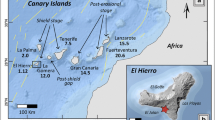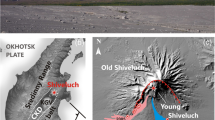Abstract
Gabbroic and ultramafic xenoliths and olivine and clinopyroxene phenocrysts in basaltic rocks from Gran Canaria, La Palma, El Hierro, Lanzarote and La Gomera (Canary Islands) contain abundant CO2-dominated fluid inclusions. Inclusion densities are strikingly similar on a regional scale. Histogram maxima correspond to one or more of the following pressures: (1) minimum 0.55 to 1.0 GPa (within the upper mantle); (2) between 0.2 and 0.4 GPa (the Moho or the lower crust); (3) at about 0.1 GPa (upper crust). Fluid inclusions in several rocks show a bimodal density distribution, the lower-density maximum comprising both texturally early and late inclusions. This is taken as evidence for an incomplete resetting of inclusion densities, and simultaneous formation of young inclusions, at well-defined magma stagnation levels. For Gran Canaria, pressure estimates for early inclusions in harzburgite and dunite xenoliths and olivine phenocrysts in the host basanites overlap at 0.9 to 1.0 GPa, indicating that such magma reservoir depths coincide with levels of xenolith entrainment into the magmas. Magma chamber pressures within the mantle, inferred to represent levels of mantle xenolith entrainment, are 0.65–0.95 GPa for El Hierro, 0.60–0.68 GPa for La Palma, and 0.55–0.75 GPa for Lanzarote. The highest-density fluid inclusions in many Canary Island mantle xenoliths have probably survived in-situ near-isobaric heating at the depth of xenolith entrainment. Inclusion data from all islands indicate ponding of basaltic magmas at Moho or lower crustal depths, and possibly at an additional higher level, strongly suggestive of two main crustal accumulation levels beneath each island. We emphasize that repeated magmatic underplating of primitive magmas, and therefore intrusive accretion, are important growth mechanisms for the Canary Islands, and by analogy, for other ocean islands. Comparable fluid inclusion data from primitive rocks in other tectonic settings, including Iceland, Etna and continental rift systems (Hungary, South Norway), indicate that magma accumulation close to Moho depths shortly before eruption is not, however, restricted to oceanic intraplate volcanoes. Lower crustal ponding and crystallization prior to eruption may be the rule rather than the exception, independent of the tectonic setting.
Similar content being viewed by others
Author information
Authors and Affiliations
Additional information
Received: 30 May 1997 / Accepted: 6 February 1998
Rights and permissions
About this article
Cite this article
Hansteen, T., Klügel, A. & Schmincke, HU. Multi-stage magma ascent beneath the Canary Islands: evidence from fluid inclusions. Contrib Mineral Petrol 132, 48–64 (1998). https://doi.org/10.1007/s004100050404
Issue Date:
DOI: https://doi.org/10.1007/s004100050404




